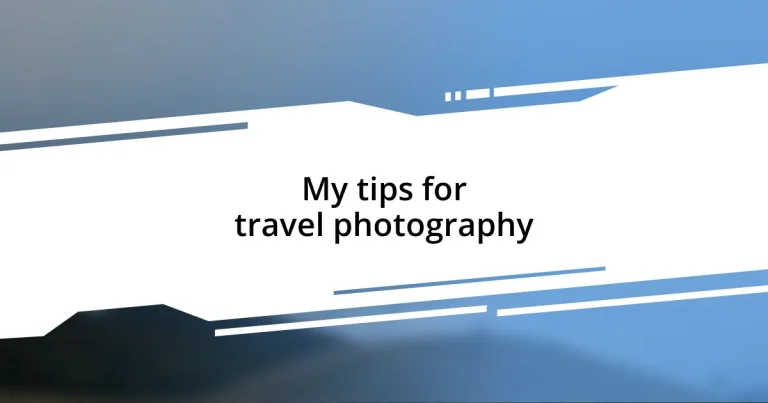Key takeaways:
- Choose lightweight, versatile gear that complements your shooting style for easier and more spontaneous photography.
- Master camera settings (aperture, shutter speed, ISO) to adapt to various lighting conditions and enhance image quality.
- Explore unique locations off the beaten path to capture extraordinary moments and tell compelling stories through your photography.
- Engage with your audience by sharing your photos online and encouraging feedback to enrich your photographic journey.

Choose the Right Gear
Choosing the right gear for travel photography can make a huge difference in your experience and the quality of your images. I remember my first trip abroad with a bulky camera that was a hassle to carry around. It taught me that sometimes, less is more—having a lightweight, versatile camera can be liberating, allowing you to capture spontaneous moments without feeling weighed down.
When selecting your gear, think about your shooting style and the type of photos you want to take. Do you prefer candid street photography, or are you drawn to sweeping landscapes? I once brought a zoom lens on a hiking trip, only to realize I missed incredible close-up opportunities of local flora because I didn’t pack my macro lens. Reflecting on that, it’s essential to ensure your gear complements your vision rather than limiting it.
Don’t forget about accessories! A sturdy tripod can change the way you capture low-light scenes, and filters can help enhance colors. I can’t count how many times an ND filter helped me achieve that dreamy waterfall effect. Have you ever wondered how professional photographers seem to nail the shot every time? Often, it’s not just their skill, but the right tools that allow them to unlock their creativity.

Master Camera Settings
Mastering camera settings is crucial for capturing stunning travel photos. I’ve found that familiarizing myself with my camera’s exposure triangle—aperture, shutter speed, and ISO—can dramatically alter my images. For instance, while hiking in the Scottish Highlands, I adjusted my settings to create a shallow depth of field, resulting in a soft background that beautifully highlighted a lone thistle amidst the rugged scenery. Understanding how these settings interact allows me to adapt quickly to changing light conditions and subjects.
Here are some key camera settings to experiment with:
- Aperture (f-stop): Controls the amount of light entering the lens. A lower f-stop like f/2.8 lets in more light and provides a blurry background, ideal for portraits.
- Shutter Speed: Essential for freezing fast action or capturing movement. A speed of 1/500s can freeze a bird in flight, while slower speeds can create a sense of motion in flowing water.
- ISO: Adjusts your camera’s sensitivity to light. Higher ISO settings (like 1600) work well in dimly lit environments, but can also introduce noise, affecting image quality.
- White Balance: Ensures accurate color representation. I often switch settings based on lighting conditions; for instance, using the cloudy setting on overcast days enhances warmth.
- Focus Mode: Choose between single-point or continuous autofocus. I prefer continuous when shooting wildlife, as subjects can move unexpectedly.
By actively experimenting with these settings, I’ve transformed fleeting moments into vibrant photographic memories.

Find Unique Locations
Finding unique locations can truly elevate your travel photography. I often seek out lesser-known spots over popular tourist destinations to capture the essence of a place. For instance, while wandering through the cobblestone streets of an undiscovered European village at dawn, the soft light created a magical atmosphere that I was fortunate enough to capture without the distraction of crowds. Those moments—where the ordinary transforms into the extraordinary—are my favorite.
It’s all about exploration and being open to unexpected discoveries. One time, I stumbled upon a hidden waterfall while hiking off the beaten path. The isolation and tranquility made that moment feel sacred, and my photos beautifully reflected the raw beauty of nature. Have you ever been surprised by the hidden gems you found while just wandering? I believe the best locations often require a little adventure, letting curiosity lead the way.
I encourage you to do some research before you embark on your trip. Look for local blogs, photography forums, or Instagram spots that aren’t in the usual guidebooks. I’ve found some incredible locations using hashtags that reveal unique scenes, like a vibrant street mural or a quaint café tucked away in an alleyway. Embracing these unconventional places has often led me to capture captivating stories through my lens.
| Common Locations | Unique Locations |
|---|---|
| Tourist attractions (e.g., Eiffel Tower) | Local markets or hidden parks |
| Bustling city streets | Quiet, peaceful side streets |
| Famous landmarks | Underrated natural spots |

Utilize Natural Light
Utilizing natural light is one of the most rewarding techniques in travel photography. I vividly remember an early morning in Santorini when I found myself at the edge of a cliff. The golden hour light spilled across the whitewashed buildings, casting long shadows and enhancing the vibrant blue sea. This soft, diffused light beautifully accentuated the architecture, making each shot feel ethereal. Have you ever watched the world transform under the sun’s gentle glow? It’s magic.
When shooting in natural light, timing becomes everything. Midday sunlight can be harsh and create unflattering shadows, so I often seek shade or wait for the softer early morning or late afternoon light. One afternoon in Kyoto, I decided to stroll through the bamboo grove around dusk. The light filtering through the towering stalks added depth to my images, and I felt an overwhelming sense of serenity. The colors and textures came alive in a way that harsh mid-day sunlight simply couldn’t replicate.
I find that natural light can also evoke specific moods. For instance, cloudy days can create a moody, dramatic backdrop. I remember capturing reflections in puddles on a rainy day in London; the overcast sky provided a soft box effect, making the colors pop just right. What about you? How does the changing light influence the images you create? Tuning into these nuances can make your photographs not just visually appealing but emotionally resonant as well.

Capture Candid Moments
Capturing candid moments is like freezing happiness in time. I remember a lively street festival in Mexico where I saw a little girl twirling in her bright dress, completely lost in her own joy. In that split second, I knew I had to click the shutter. It’s these genuine emotions that often tell the most captivating stories in travel photography. Have you ever found yourself mesmerized by a spontaneous event unfolding right in front of you?
I’ve learned that the key to capturing these moments is subtlety. Instead of forcing interactions, I often prefer to blend in with the surroundings. On a busy day in a bustling market, I sat quietly with my camera ready, and, suddenly, a vendor shared a hearty laugh with a customer over a mishap with a banana. My heart raced as I pressed the shutter, capturing their unguarded connection. Those snippets of life remind me that true beauty often lies in spontaneity rather than posed perfection.
To enhance your candid photography, focus on anticipating moments rather than just reacting to them. I often immerse myself in the environment, watching for unique interactions, like a couple dancing to street music or friends sharing a laugh. In Venice, I stood on a bridge and observed a group of gondoliers joking around as they tied up their boats. It felt like a blessing to witness this camaraderie and the laughter became a pivotal part of my photo collection. Isn’t it amazing how a fleeting moment can become a memory you’ll cherish forever?

Edit Your Photos Effectively
Editing your photos effectively can elevate your travel photography from good to exceptional. I remember sitting in a cozy café in Paris after a full day of shooting. As I went through the images on my laptop, I felt a sense of excitement—these photos held memories, but a little editing was necessary to bring them to life. With tools like Lightroom, I could enhance colors and balance the exposure, transforming an ordinary shot of the Eiffel Tower into something magical. How often do you revisit your photos and realize their potential with just a few tweaks?
One of the vital aspects of editing is knowing when to enhance and when to simplify. A little clarity can sharpen the details, but overdoing it can make the image feel unnatural. I recall editing a sunset shot on my trip to Bali; I boosted the vibrancy of the oranges and pinks but resisted the urge to push the saturation too far. The result was a breathtaking image that felt like the scene I experienced in real life. Have you ever found yourself over-editing an image only to step back and see it didn’t reflect your original vision?
Don’t forget about cropping! It can dramatically change the composition and impact of a photo. I once had a beautifully composed shot of local fishermen in Greece, but there was a distracting element in the corner. A simple crop helped focus on the fishermen, making the scene more intimate and compelling. Cropping isn’t just about cutting out distractions; it can also create a sense of balance or tension in the frame. What do you find most challenging when it comes to editing your travel photographs? Embracing editing as a storytelling tool can enhance your images and allow them to convey the emotions and experiences you felt during those fleeting moments.

Share and Engage Online
Sharing your travel photography online transforms your experiences into a dialogue with your audience. When I uploaded my photos from a sunrise hike in the Swiss Alps, I felt a rush of excitement, wondering how others would react. Engaging with viewers is more than just posting images; it’s about inviting them to share in the beauty and emotions of those moments. Have you ever felt that thrill of connection through your photos?
Utilizing social media platforms like Instagram and Pinterest not only showcases your work, but also expands your audience. I remember posting a series of photos from a street art tour in Berlin, tagging local artists, which unexpectedly led to conversations and collaborations. It’s a powerful reminder that your photography can inspire others and create community. How often do you interact with your followers and let their insights help shape your creative journey?
Encouraging feedback on your images can lead to valuable discussions. After posting a shot of locals dancing at a festival in Peru, I received comments about the cultural significance of their movements. This interaction allowed me to deepen my understanding and share richer stories behind my work. Why not take a moment to ask your audience questions about their own experiences with travel and photography? Engaging with them can reveal new perspectives and enrich your own journey. It’s that mutual exchange that adds depth to your art.












